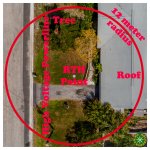- Joined
- Mar 14, 2019
- Messages
- 4
- Reaction score
- 1
RTH safety issue: This picture illustrates my normal work setup for real estate photography. Within 10 meters radius is a roof, a tree, a power line. If RTH starts within that radius, I noticed the drone goes down first and then moves horizontally to RTH. This could hit a power line and knock out power to a whole neigborhoud. I suggest for safety reasons the done should always first keep altitude during RTH, even if close to RTH, and last it should decent only once it right above RTH point. It should be an easy firmware fix, and it could prevent very expensive accidents.



